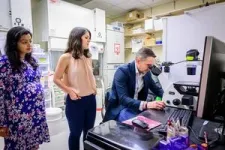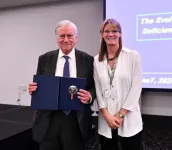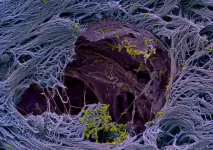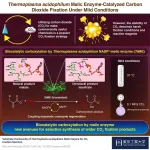(Press-News.org) CHAMPAIGN, Ill. — When scientists transplanted the gut microbes of aged mice into young “germ-free” mice — raised to have no gut microbes of their own — the recipient mice experienced an increase in inflammation that parallels inflammatory processes associated with aging in humans. Young germ-free mice transplanted with microbes from other young mice had no such increase.
The findings suggest that changes to the gut microbiome play a role in the systemwide inflammation that often occurs with aging, the researchers said.
Reported in the journal Aging Cell, the study also found that antibiotics caused longer-lasting disruptions in the gut microbiomes of aged mice than in young mice.
“There’s been a growing consensus that aging is associated with a progressive increase in chronic low-grade inflammation,” said Jacob Allen, a professor of kinesiology and community health at the University of Illinois Urbana-Champaign who led the new research with Thomas Buford, a professor of medicine at the University of Alabama at Birmingham. “And there’s a kind of debate as to what drives this, what is the major cause of the aging-induced inflammatory state. We wanted to understand if the functional capacity of the microbiome was changing in a way that might contribute to some of the inflammation that we see with aging.”
Previous studies have found associations between age-related changes in the microbial composition of the gut and chronic inflammatory diseases such as Parkinson’s disease and Alzheimer’s disease. Some studies have linked microbial metabolism to an individual’s susceptibility to other health conditions, including obesity, irritable bowel syndrome and heart disease. Age-related changes in the gut microbiome also may contribute to the so-called leaky gut problem, the researchers said.
“Microbiome patterns in aged mice are strongly associated with signs of bacterial-induced barrier disruption and immune infiltration,” they wrote.
“The things that are in our gut are supposed to be kept separate from the rest of our system,” Buford said. “If they leak out, our immune system is going to recognize them. And so then the question was: ‘Is that a source of inflammation?’”
Many studies have compared the relative abundance and diversity of species of microbes in the gut, offering insight into some of the major groups that contribute to health or disease. But sequencing even a portion of the microbes in the gut is expensive and the results can be difficult to interpret, Allen said. That is why he and his colleagues focused on microbial function — specifically, how the gut microbiomes of aging mice might spur an immune response.
The team focused on toll-like receptors, molecules that mediate inflammatory processes throughout the body. TLRs sit in cellular membranes and sample the extracellular environment for signs of tissue damage or infection. If a TLR encounters a molecule associated with a potential pathogen — for example, a lipopolysaccharide component of a gram-negative bacterium — it activates an innate immune response, calling in pro-inflammatory agents and other molecules to fight the infection.
The researchers first evaluated whether the colonic contents of young and aged mice were likely to promote TLR signaling. They found that microbes from aged mice were more likely than those from young mice to activate TLR4, which can sense lipopolysaccharide components of bacterial cell walls. A different receptor, TLR5, was not affected differently in aged or young mice. TLR5 senses a different bacterial component, known as flagellin.
Young germ-free mice transplanted with the microbes of aged mice also experienced higher inflammatory signaling and increased levels of lipopolysaccharides in the blood after the transplants, the team found.
This finding provides “a direct link between aging-induced shifts in microbiota immunogenicity and host inflammation,” the researchers wrote.
In other experiments, the team treated mice with broad-spectrum antibiotics and tracked changes in the microbiomes during treatment and for seven days afterward.
“One of the most interesting questions for me was what microbes come back immediately after the treatment with antibiotics ends,” Buford said. And in the mice with aged microbiota in their guts, “these opportunistic pathogens were the most quick to come back.”
“It appears that as we age our microbiome might be less resilient to antibiotic challenges,” Allen said. “This is important because we know that in the U.S. and other Western societies, we’re increasingly exposed to more antibiotics as we age.”
The study is an important step toward understanding how age-related microbial changes in the gut may affect long-term health and inflammation, the researchers said.
Coauthors of the study also included Illinois postdoctoral researcher Elisa Caetano-Silva; U. of I. Ph.D. student Akriti Shrestha; National Children’s Hospital research scientist Michael Bailey; and Jeffrey Woods, the director of the Center on Health, Aging and Disability at Illinois.
Allen also is a professor of nutritional sciences at Illinois and an affiliate of the Carl R. Woese Institute for Genomic Biology at the U. of I.
The National Institutes of Health supported this research.
Editor’s notes:
To reach Jacob Allen, email jmallen5@illinois.edu.
To reach Thomas Buford, email twbuford@uabmc.edu.
The paper “Aging amplifies a gut microbiota immunogenic signature linked to heightened inflammation” is available online.
DOI: https://doi.org/10.1111/acel.14190
END
The European Society for Clinical Investigation (ESCI) is awarding Valentin Fuster, MD, PhD, President of Mount Sinai Heart and Physician-in-Chief of The Mount Sinai Hospital, its ESCI Distinguished Medal for 2024. He received this honor during the ESCI Annual Scientific Meeting in Barcelona, Spain, during a special ceremony on Friday, June 7.
The ESCI Medal is awarded yearly for outstanding achievements in clinical investigation and for the teaching of young scientists and medical specialists.
This prestigious recognition highlights Dr. Fuster’s significant contributions to the worldwide field of cardiology. Dr. Fuster’s work has been ...
Embargoed for release: Monday, June 10, 7:00 AM ET
Key takeaways:
People whose diets most closely adhered to the Planetary Health Diet (PHD) had 30% lower risk of premature death compared to those with the lowest adherence.
Every major cause of death, including cancer, heart disease, and lung disease, was lower with greater adherence to this dietary pattern.
Diets adhering to the PHD pattern had substantially lower environmental impact, including 29% lower greenhouse gas emissions and 51% less land use.
Boston, MA—People who eat a healthy, sustainable diet may ...
Scientists at the Broad Institute of MIT and Harvard have improved a gene-editing technology that is now capable of inserting or substituting entire genes in the genome in human cells efficiently enough to be potentially useful for therapeutic applications.
The advance, from the lab of Broad core institute member David Liu, could one day help researchers develop a single gene therapy for diseases such as cystic fibrosis that are caused by one of hundreds or thousands of different mutations in a gene. Using this new approach, they would insert a healthy copy of the gene at its native location in the genome, rather than having to create a different ...
How do pathogens invade the lungs? Using human lung microtissues, a team at the Biozentrum of the University of Basel has uncovered the strategy used by a dangerous pathogen. The bacterium targets specific lung cells and has developed a sophisticated strategy to break through the lungs’ line of defense.
Earlier this year, the WHO published a list of twelve of the world’s most dangerous bacterial pathogens that are resistant to multiple antibiotics and pose a grave threat to human health. This list includes Pseudomonas aeruginosa, a much-feared nosocomial pathogen ...
Around two million years ago, Earth was a very different place, with our early human ancestors living alongside saber-toothed tigers, mastodons, and enormous rodents. And, depending on where they were, they may have been cold: Earth had fallen into a deep freeze, with multiple ice ages coming and going until about 12,000 years ago. Scientists theorize that ice ages occur for a number of reasons, including the planet’s tilt and rotation, shifting plate tectonics, volcanic eruptions, and carbon dioxide levels in the atmosphere. ...
Lasers have revolutionized the world since the 60’s and are now indispensable in modern applications, from cutting-edge surgery and precise manufacturing to data transmission across optical fibers.
But as the need for laser-based applications grows, so do challenges. For example, there is a growing market for fiber lasers, which are currently used in industrial cutting, welding, and marking applications.
Fiber lasers use an optical fiber doped with rare-earth elements (erbium, ytterbium, neodymium etc) as their optical gain source (the part that produces the laser’s light). They emit high-quality beams, they have high power output, and they are efficient, ...
ROCKVILLE, Md.— New research reveals that moderate to vigorous physical activity in the evening for sedentary adults with overweight and obesity is most beneficial in lowering daily blood sugar levels, according to a study published in Obesity, The Obesity Society’s (TOS) flagship journal.
Experts explain that it has been well established that moderate to vigorous physical activity enhances glucose homeostasis in adults with overweight and obesity who are at higher risk of developing insulin resistance. ...
ROCKVILLE, Md.— Individuals treated with anti-obesity medications generally experience reduced appetite, which typically leads to reduced food intake. As a result, dietary quality becomes more important because nutritional needs must be met within the context of eating less. To improve this process, medical experts have developed a list of evidence-based nutritional recommendations to assist clinicians treating patients with anti-obesity medications, according to a review published in the journal Obesity, The Obesity Society’s (TOS) flagship journal.
“Our evidence-based review aims to equip clinicians with knowledge ...
Boys are good at math, girls not so much? A study from the University of Zurich has analyzed the social mechanisms that contribute to the gender gap in math confidence. While peer comparisons seem to play a crucial role for boys, girls’ subjective evaluations are more likely to be based on objective performance.
Research has shown that in Western societies, the average secondary school girl has less confidence in her mathematical abilities than the average boy of the same age. At the same time, no significant difference ...
Carbon capture and utilization technologies for the conversion of carbon dioxide into carboxylic acids have garnered attention recently, with researchers from Tokyo Tech recently demonstrating a biocatalyzed carboxylation reaction of not only natural substrate, pyruvate, but also unnatural one, 2-ketoglutarate, using Thermoplasma acidophilum NADP+- malic enzyme under mild reaction conditions. The proposed strategy can be tailored for the selective synthesis through carbon dioxide fixation reactions.
Removing the excess carbon dioxide (CO2) from the environment is not the end goal of the decarbonization process necessary to ...






